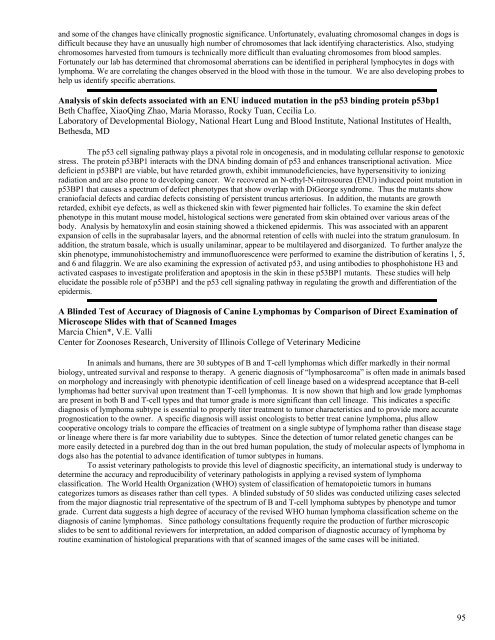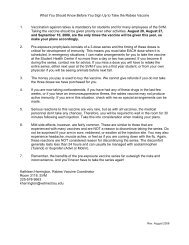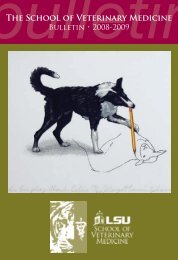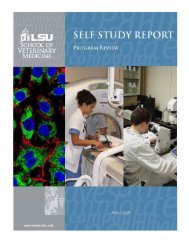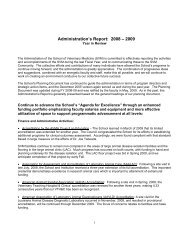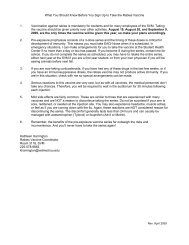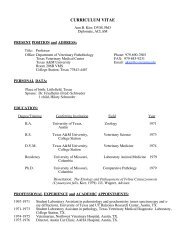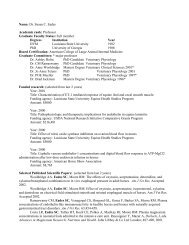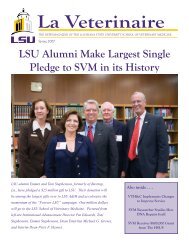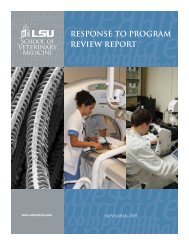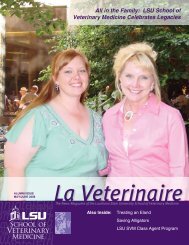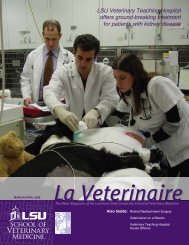PATHOLOGY, TOXICOLOGY, AND ONCOLOGY (SESSION1)DNA damage response and p53 dysregulation in inflammatory bowel disease.Tia Bobo*, Jane Sohn, Perwez Hussain, and Curtis HarrisLaboratory <strong>of</strong> Human Carcinogenesis, National Cancer Institute, National Institutes <strong>of</strong> Health, Bethesda, MD20892P53 activation leads to decreased regulation <strong>of</strong> cell cycle checkpoints, DNA repair, and apoptosis, contributing togenomic instability as well as dysregulated cell growth. DNA damage response has been suggested as the driving forcebehind p53 dysregulation in human cancer (Bartkova <strong>2006</strong>, Gorgoulis 2005). Activation <strong>of</strong> p53, through phoshorylation, hasbeen shown to be associated with inflammation in ulcerative colitis (H<strong>of</strong>seth 2003). Ulcerative colitis and Crohn’s disease arediseases <strong>of</strong> chronic inflammation associated with risk for colorectal cancer. The phosphorylation status <strong>of</strong> p53 has beenstudied in ulcerative colitis, however, activation <strong>of</strong> this tumor suppressor gene has not been explored in humans with Crohn’sdisease. We hypothesize that the activation <strong>of</strong> DNA damage response will be associated with phosphorylation <strong>of</strong> p53 in bothulcerative colitis and Crohn’s disease tissue undergoing chronic inflammation. To test our hypothesis, we are performingimmunohistochemistry using antibodies for phospho-p53 (ser15) and gamma H2AX, a marker for DNA damage response,using inflamed and uninflamed tissue from patients with inflammatory bowel disease. Colon tumor tissue is being used as apositive control while normal colon tissue from autopsy patients serves as negative controls. As we are still optimizing oursamples, we hope to correlate activation <strong>of</strong> p53 with initiation <strong>of</strong> the DNA damage response pathway, which may signalprogression into cancer.Identification <strong>of</strong> Cancer-Associated Genes in Canine Malignant Histiocytosis and Hemangiosarcoma UsingSingle Locus Probe Fluorescence in situ Hybridization (FISH) AnalysisKeara Boss* 1 , Jaime Venezia* 2 , Rachael Thomas 3 , Tessa Breen 4 , Shannon Duke 3 , John Cullen 5 , Matthew Breen 31Class <strong>of</strong> 2008, NCSU-CVM, Raleigh, NC, 2 Class <strong>of</strong> 2009, Cornell-CVM, Ithaca, NY, 3 Dept. <strong>of</strong> MolecularBiomedical Sciences, NCSU-CVM, Raleigh, NC, 4 Dept. <strong>of</strong> Clinical Sciences, NCSU-CVM, Raleigh, NC, 5 Dept.<strong>of</strong> Population Health and Pathobiology, NCSU-CVM, Raleigh, NC* authors contributed equally to this workMalignant histiocytosis (MH) and hemangiosarcoma (HSA) are both highly invasive neoplasms with significantmetastatic potential that are among the most challenging tumor types encountered in veterinary practice. MH involvesmassive proliferation <strong>of</strong> atypical histiocytes, derived from dendritic cells <strong>of</strong> the immune system. The Bernese Mountain dogis a breed at high risk for developing this cancer, with the median age <strong>of</strong> affected dogs being only six years. HSA is amalignancy <strong>of</strong> vascular endothelial origin that usually affects middle aged to older dogs, and is also frequently found in theBernese Mountain dog, as well as in the Flat-Coated Retriever. This cancer has a strong predilection for the spleen, heart andsubcutaneous sites. In both diseases, malignant lesions are <strong>of</strong>ten evident in multiple sites in the patient upon presentation;therefore, surgery, chemotherapy, and radiation therapy are not always viable therapeutic options. Affected patients usuallydie within a few months <strong>of</strong> diagnosis.Tumor biopsies <strong>of</strong> confirmed cases <strong>of</strong> MH cases have been previously assessed at NCSU for the presence <strong>of</strong>recurrent genome-wide chromosome copy number changes using array comparative genomic hybridization (aCGH). Theaim <strong>of</strong> the present study is to validate the findings <strong>of</strong> the aCGH data by interrogating tumor chromosome preparations andinterphase nuclei with multicolor single locus probe (SLP) fluorescence in situ hybridization (FISH) analysis. BAC clonesfrom the arrayed panel, which map within the specific regions <strong>of</strong> interest, are used as probes to evaluate their copy numberstatus in cell populations comprising the MH malignancies.In addition, we are working on optimizing a protocol for the extraction <strong>of</strong> HSA cells from formalin fixed paraffinembeddedtissue. Subsequent SLP FISH analysis on HSA cases will also be used to validate the results <strong>of</strong> aCGH data.Determining the cytogenetic pr<strong>of</strong>ile for MH and HSA will aid in the early detection <strong>of</strong> these diseases and may initiatedevelopment <strong>of</strong> more appropriate therapeutic options.Chromosomal aberrations correlated with lymphomaMichela Bullone, Jennifer Devitt, Dr Susan LaRueColorado <strong>State</strong> UniversityRecurrent chromosomal aberrations are frequently observed in human neoplastic cells and <strong>of</strong>ten correlate with otherclinical and histopathological parameters <strong>of</strong> a given tumour type. The clinical presentation, histology and biology <strong>of</strong> manycanine cancers closely parallel those <strong>of</strong> human malignancies. Since human beings and dogs demonstrate extensive genomehomology and share the same environment, it is not surprising that canine cancers have also been associated with recurrentchromosomal aberrations. Canine lymphoma is a common tumor that initially responds to chemotherapy, but generally recursand results in death. Recurrent aberrations have been identified in a number <strong>of</strong> chromosomes including 11, 13, 14 and 31.,94
and some <strong>of</strong> the changes have clinically prognostic significance. Unfortunately, evaluating chromosomal changes in dogs isdifficult because they have an unusually high number <strong>of</strong> chromosomes that lack identifying characteristics. Also, studyingchromosomes harvested from tumours is technically more difficult than evaluating chromosomes from blood samples.Fortunately our lab has determined that chromosomal aberrations can be identified in peripheral lymphocytes in dogs withlymphoma. We are correlating the changes observed in the blood with those in the tumour. We are also developing probes tohelp us identify specific aberrations.Analysis <strong>of</strong> skin defects associated with an ENU induced mutation in the p53 binding protein p53bp1Beth Chaffee, XiaoQing Zhao, Maria Morasso, Rocky Tuan, Cecilia Lo.Laboratory <strong>of</strong> Developmental Biology, National Heart Lung and Blood Institute, National Institutes <strong>of</strong> Health,Bethesda, MDThe p53 cell signaling pathway plays a pivotal role in oncogenesis, and in modulating cellular response to genotoxicstress. The protein p53BP1 interacts with the DNA binding domain <strong>of</strong> p53 and enhances transcriptional activation. Micedeficient in p53BP1 are viable, but have retarded growth, exhibit immunodeficiencies, have hypersensitivity to ionizingradiation and are also prone to developing cancer. We recovered an N-ethyl-N-nitrosourea (ENU) induced point mutation inp53BP1 that causes a spectrum <strong>of</strong> defect phenotypes that show overlap with DiGeorge syndrome. Thus the mutants showcrani<strong>of</strong>acial defects and cardiac defects consisting <strong>of</strong> persistent truncus arteriosus. In addition, the mutants are growthretarded, exhibit eye defects, as well as thickened skin with fewer pigmented hair follicles. To examine the skin defectphenotype in this mutant mouse model, histological sections were generated from skin obtained over various areas <strong>of</strong> thebody. Analysis by hematoxylin and eosin staining showed a thickened epidermis. This was associated with an apparentexpansion <strong>of</strong> cells in the suprabasalar layers, and the abnormal retention <strong>of</strong> cells with nuclei into the stratum granulosum. Inaddition, the stratum basale, which is usually unilaminar, appear to be multilayered and disorganized. To further analyze theskin phenotype, immunohistochemistry and immun<strong>of</strong>luorescence were performed to examine the distribution <strong>of</strong> keratins 1, 5,and 6 and filaggrin. We are also examining the expression <strong>of</strong> activated p53, and using antibodies to phosphohistone H3 andactivated caspases to investigate proliferation and apoptosis in the skin in these p53BP1 mutants. These studies will helpelucidate the possible role <strong>of</strong> p53BP1 and the p53 cell signaling pathway in regulating the growth and differentiation <strong>of</strong> theepidermis.A Blinded Test <strong>of</strong> Accuracy <strong>of</strong> Diagnosis <strong>of</strong> Canine Lymphomas by Comparison <strong>of</strong> Direct Examination <strong>of</strong>Microscope Slides with that <strong>of</strong> Scanned ImagesMarcia Chien*, V.E. ValliCenter for Zoonoses Research, University <strong>of</strong> Illinois College <strong>of</strong> <strong>Veterinary</strong> <strong>Medicine</strong>In animals and humans, there are 30 subtypes <strong>of</strong> B and T-cell lymphomas which differ markedly in their normalbiology, untreated survival and response to therapy. A generic diagnosis <strong>of</strong> “lymphosarcoma” is <strong>of</strong>ten made in animals basedon morphology and increasingly with phenotypic identification <strong>of</strong> cell lineage based on a widespread acceptance that B-celllymphomas had better survival upon treatment than T-cell lymphomas. It is now shown that high and low grade lymphomasare present in both B and T-cell types and that tumor grade is more significant than cell lineage. This indicates a specificdiagnosis <strong>of</strong> lymphoma subtype is essential to properly titer treatment to tumor characteristics and to provide more accurateprognostication to the owner. A specific diagnosis will assist oncologists to better treat canine lymphoma, plus allowcooperative oncology trials to compare the efficacies <strong>of</strong> treatment on a single subtype <strong>of</strong> lymphoma rather than disease stageor lineage where there is far more variability due to subtypes. Since the detection <strong>of</strong> tumor related genetic changes can bemore easily detected in a purebred dog than in the out bred human population, the study <strong>of</strong> molecular aspects <strong>of</strong> lymphoma indogs also has the potential to advance identification <strong>of</strong> tumor subtypes in humans.To assist veterinary pathologists to provide this level <strong>of</strong> diagnostic specificity, an international study is underway todetermine the accuracy and reproducibility <strong>of</strong> veterinary pathologists in applying a revised system <strong>of</strong> lymphomaclassification. The World Health Organization (WHO) system <strong>of</strong> classification <strong>of</strong> hematopoietic tumors in humanscategorizes tumors as diseases rather than cell types. A blinded substudy <strong>of</strong> 50 slides was conducted utilizing cases selectedfrom the major diagnostic trial representative <strong>of</strong> the spectrum <strong>of</strong> B and T-cell lymphoma subtypes by phenotype and tumorgrade. Current data suggests a high degree <strong>of</strong> accuracy <strong>of</strong> the revised WHO human lymphoma classification scheme on thediagnosis <strong>of</strong> canine lymphomas. Since pathology consultations frequently require the production <strong>of</strong> further microscopicslides to be sent to additional reviewers for interpretation, an added comparison <strong>of</strong> diagnostic accuracy <strong>of</strong> lymphoma byroutine examination <strong>of</strong> histological preparations with that <strong>of</strong> scanned images <strong>of</strong> the same cases will be initiated.95
- Page 1 and 2:
2006 MERCK/MERIALNATIONAL VETERINAR
- Page 6 and 7:
3:00-3:30 pm BreakNovel therapy for
- Page 8 and 9:
KEYNOTE SPEAKERRonald Veazey, D.V.M
- Page 10 and 11:
Mini Symposium II:Fish Research: A
- Page 12 and 13:
David G. Baker, D.V.M., M.S., Ph.D.
- Page 14 and 15:
Konstantin G. Kousoulas, Ph.D.Profe
- Page 16 and 17:
Joseph Francis, B.V.Sc., M.V.Sc., P
- Page 18 and 19:
dogs with cancer, the potential rol
- Page 20 and 21:
2006 MERCK/MERIALVETERINARY SCHOLAR
- Page 22 and 23:
YOUNG INVESTIGATOR AWARD HONORABLE
- Page 24 and 25:
Mammary epithelial-specific deletio
- Page 26 and 27:
2006 MERCK/MERIALVETERINARY SCHOLAR
- Page 28:
Variation in Q-Tract Length of the
- Page 34:
Novel therapy for humoral hypercalc
- Page 38:
ALTERNATE:Micron-scale membrane sub
- Page 42 and 43:
ABSTRACT TITLES LISTED BY CATEGORY
- Page 44 and 45: 19. A pilot study of cigarette smok
- Page 46 and 47: 36. Development of a murine in vitr
- Page 48 and 49: ABSTRACT TITLES LISTED BY CATEGORY
- Page 50 and 51: 71. Identification and characteriza
- Page 52 and 53: 85. Age and Gender Influence Ventil
- Page 54 and 55: ABSTRACT TITLES LISTED BY CATEGORY
- Page 56 and 57: 2006 MERCK/MERIALVETERINARY SCHOLAR
- Page 58 and 59: 10. Preliminary estimation of risk
- Page 60 and 61: ABSTRACT TITLES LISTED BY CATEGORY
- Page 62 and 63: 47. Osteoprotegerin and Receptor Ac
- Page 64 and 65: 61. A Comparison of Interaction Pat
- Page 66 and 67: ABSTRACT TITLES LISTED BY CATEGORY
- Page 68 and 69: ABSTRACT TITLES LISTED BY CATEGORY
- Page 70 and 71: ABSTRACT TITLES LISTED BY CATEGORY
- Page 72 and 73: 2006 MERCK/MERIALVETERINARY SCHOLAR
- Page 74 and 75: used to label avian heterophils for
- Page 76 and 77: obtained via analysis of time and d
- Page 78 and 79: 0.71mg/dL; p=0.001). Values for hem
- Page 80 and 81: mass and fecundity in prespawning w
- Page 82 and 83: Equine Hoof Laminae Tissue Collecti
- Page 84 and 85: Aspiration Pneumonia in DogsDavid A
- Page 86 and 87: Distortion Product Otoacoustic Emis
- Page 88 and 89: tyrosine phosphorylation is measure
- Page 90 and 91: the gravid and non-gravid females t
- Page 92 and 93: egulatory function as its ortholog,
- Page 96 and 97: Markers of Oxidative Stress in plas
- Page 98 and 99: has been isolated from all samples
- Page 100 and 101: Matrix metalloproteinase secretion
- Page 102 and 103: Reproductive performance, neonatal
- Page 104 and 105: control to determine the efficiency
- Page 106 and 107: Enhancing the Quality and Reliabili
- Page 108 and 109: grade II MCTs into groups with good
- Page 110 and 111: Transcriptional Regulation of the I
- Page 112 and 113: MICROBIOLOGY AND IMMUNOLOGY (SESSIO
- Page 114 and 115: colonization of the mutant and 6 re
- Page 116 and 117: digestive tracts of these and other
- Page 118 and 119: 100 pfu BRSV. The results show that
- Page 120 and 121: Inhibition of Microneme Secretion i
- Page 122 and 123: Adherent bacilli were present in th
- Page 124 and 125: isolated to analyze cytokine gene e
- Page 126 and 127: purified, viral RNA was extracted a
- Page 128 and 129: The effects of co-engagement of TLR
- Page 130 and 131: Occurrence of Leptospira Vaccine Fa
- Page 132 and 133: undifferentiated catecholaminergic
- Page 134 and 135: the concept that the greater detoxi
- Page 136 and 137: quantitative PCR using gene targets
- Page 138 and 139: Rotenone Induced Dopamine Neuron De
- Page 140 and 141: decrease in serum cortisol, with a
- Page 142 and 143: and detrimental impacts on the brai
- Page 144 and 145:
actions of cells prior to embryo de
- Page 146 and 147:
Utilizing cDNA Subtraction to Exami
- Page 148 and 149:
expression in unilaterally pregnant
- Page 150 and 151:
Salmonella is increased. Poultry sa
- Page 152 and 153:
exports. The estimated prevalence o
- Page 154 and 155:
eeding grounds near Minnedosa, MB s
- Page 156 and 157:
(PBMC) were isolated using commerci
- Page 158 and 159:
2006 MERCK/MERIALVETERINARY SCHOLAR
- Page 160 and 161:
Trainees acquire in-depth knowledge
- Page 162 and 163:
comparative pathology and/or resear
- Page 164 and 165:
Department of Veterinary Bioscience
- Page 166 and 167:
PhD, Director, Center for Comparati
- Page 168 and 169:
2006 MERCK/MERIALVETERINARY SCHOLAR
- Page 170 and 171:
MICHIGAN STATEUNIVERSITYJames Crawf
- Page 172:
UNIVERSITY OFPENNSYLVANIALindsay Th


